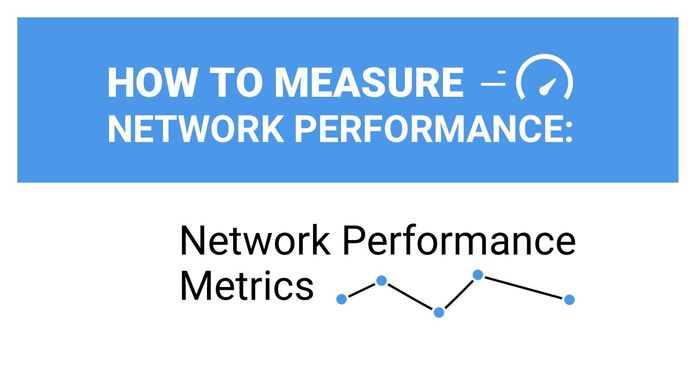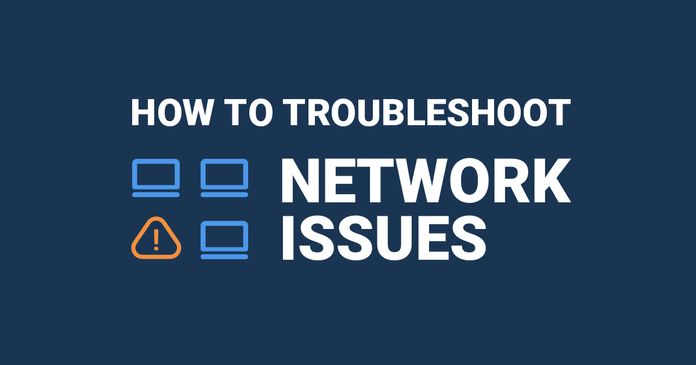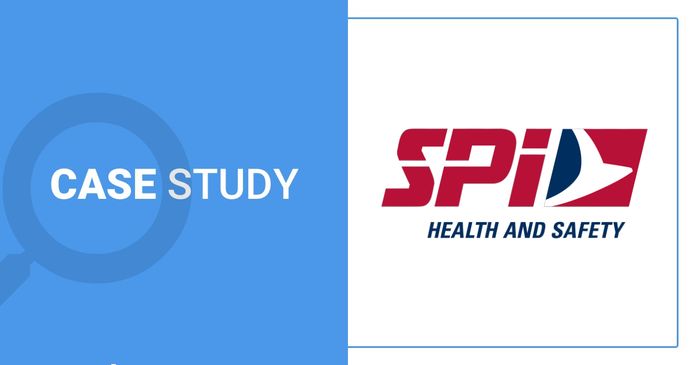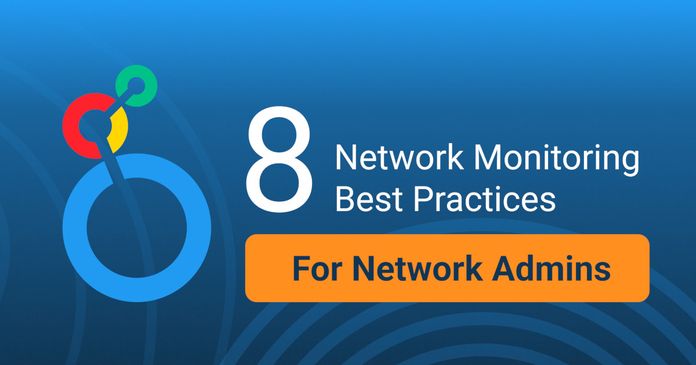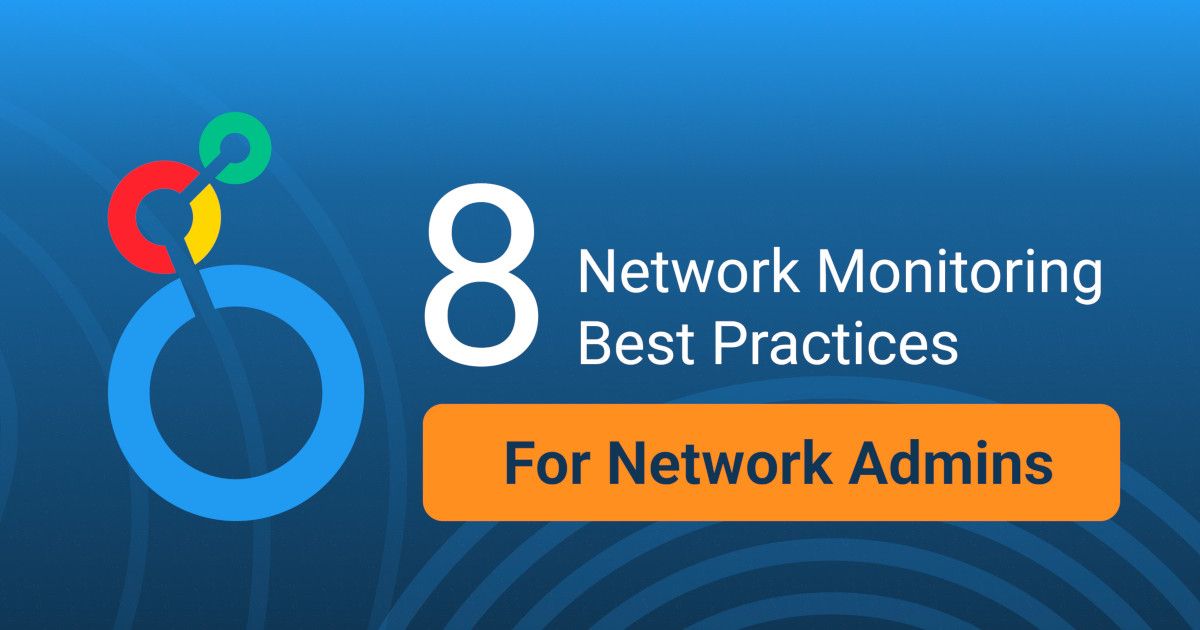Table of Contents
Table of Contents
Whether you're a small startup or a large enterprise, the health and performance of your network infrastructure are critical to your success. This is where network monitoring comes into play.
Network monitoring involves the continuous observation and analysis of network traffic, devices, and performance metrics to ensure smooth operations, detect anomalies, and troubleshoot issues promptly. However, with the complexity and scale of modern networks, manual monitoring can be overwhelming and time-consuming. This is where an effective network monitoring dashboard can make all the difference.
A network monitoring dashboard is a centralized platform that provides real-time visibility into your network's performance and health. It consolidates key metrics, data, and visualizations, empowering you to monitor, analyze, and respond to network events efficiently.
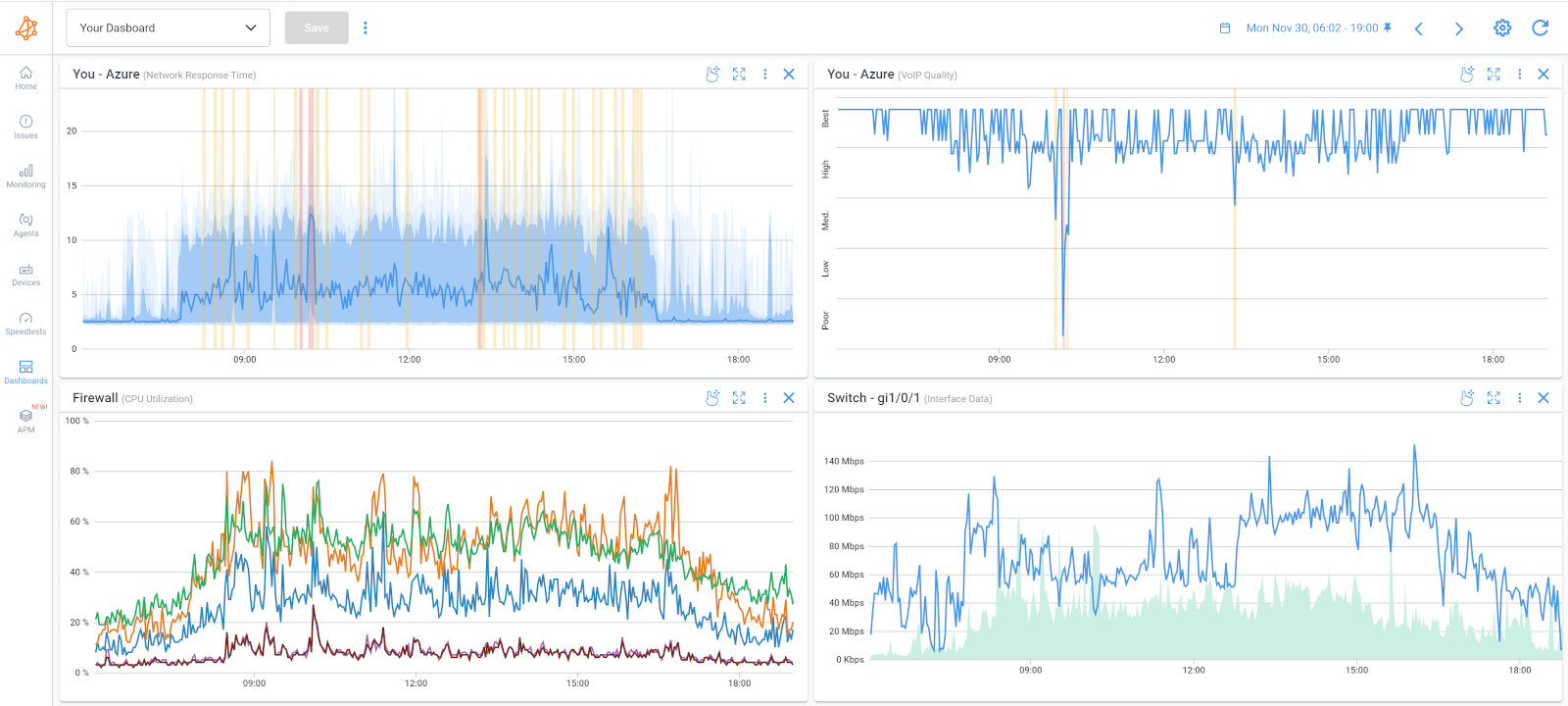
Let's explore some of the key benefits an effective network monitoring dashboard can offer:
- Enhanced Efficiency: With a well-designed dashboard, you can quickly access and review critical information, eliminating the need to sift through countless logs or navigate complex interfaces. This streamlines your monitoring process, enabling you to identify and resolve issues faster, minimizing downtime and optimizing productivity.
- Improved Decision-Making: By presenting network data in a clear and visual format, a monitoring dashboard enables you to gain valuable insights and make informed decisions. Real-time updates, intuitive visualizations, and customizable reports allow you to understand network trends, identify bottlenecks, and allocate resources effectively.
- Proactive Issue Detection: A network monitoring dashboard provides real-time alerts and notifications for potential issues or anomalies. By setting up thresholds and triggers, you can receive immediate notifications when certain metrics deviate from normal levels. This proactive approach allows you to address problems before they escalate, minimizing the impact on your network and users.
- Scalability and Growth: As your business expands, so does your network. An effective dashboard scales with your network, accommodating the increasing complexity and volume of data. It should offer flexible customization options, allowing you to add new devices, monitor additional metrics, and adapt to changing business requirements seamlessly.
- Resource Optimization: Through comprehensive monitoring and analysis, a dashboard can help you optimize resource allocation. By identifying underutilized or overburdened components, you can make data-driven decisions to optimize network performance, reduce costs, and improve overall efficiency.
- Compliance and Security: Network monitoring is essential for ensuring compliance with industry regulations and maintaining network security. A robust dashboard enables you to monitor security events, track user access, and identify potential vulnerabilities, helping you meet compliance requirements and proactively safeguard your network from cyber threats.
In this ultimate guide, we will delve into the intricacies of building an effective network monitoring dashboard. We will explore the key components, best practices, and considerations for designing a dashboard that meets your organization's unique needs. By the end of this guide, you'll have the knowledge and insights to create a powerful tool that empowers you to monitor and optimize your network infrastructure effectively.
So, let's embark on this journey together and unlock the potential of network monitoring dashboards to revolutionize the way you manage and maintain your network infrastructure.
But what exactly is network monitoring, and why is it important? In this section, we will explore the fundamental concepts of network monitoring and its significance in maintaining a robust network environment.
Network monitoring involves the continuous observation and analysis of network components, traffic patterns, and performance metrics to ensure optimal functionality, detect anomalies, and troubleshoot issues. It provides valuable insights into the health, availability, and performance of your network infrastructure.
At its core, network monitoring revolves around collecting data from various sources within your network, such as routers, switches, servers, and applications. This data includes metrics like bandwidth utilization, latency, packet loss, error rates, CPU usage and memory usage, and more. By monitoring and analyzing this data, you gain visibility into your network's behavior, identifying trends, patterns, and potential problems.
When it comes to network monitoring, certain metrics and data are essential for gauging the health and performance of your network. Here are some key metrics to consider monitoring:
- Bandwidth Utilization: Monitoring the utilization of your network bandwidth helps you identify potential bottlenecks and congestion points. By tracking bandwidth usage over time, you can proactively allocate resources and plan for future capacity requirements.
- Latency and Round-Trip Time: Latency refers to the time it takes for a packet to travel from the source to the destination and back. Monitoring latency and network round-trip time is crucial, especially for real-time applications like video conferencing or VoIP, as high latency can lead to poor user experience.
- Packet Loss: Packet loss occurs when data packets fail to reach their destination. Monitoring packet loss helps you identify network issues, such as congested or unreliable links, and take corrective actions to ensure data integrity and smooth communication.
- Error Rates: Monitoring error rates, including CRC errors, frame errors, or input/output errors, provides insights into the quality of your network connections. High error rates may indicate issues with cabling, hardware, or transmission media that need to be addressed promptly.
- Device Performance: Monitoring the performance of network devices, such as routers, switches, and firewalls, helps ensure they are operating optimally. Key performance indicators include CPU and memory usage, interface statistics, and device availability.
- Application Performance: Monitoring the performance of critical applications running on your network is essential for delivering a positive user experience. Metrics like response times, transaction rates, and error rates for applications can help you identify performance bottlenecks and address them promptly.
Learn how to measure network performance with key network metrics like throughput, latency, packet loss, jitter, packet reordering and more!
Learn more

While network monitoring offers significant benefits, it also comes with its share of challenges. Understanding these challenges is crucial for designing an effective network monitoring dashboard. Here are some common challenges you may encounter:
- Data Overload: Networks generate vast amounts of data, making it challenging to filter through and extract meaningful insights. A well-designed dashboard should provide mechanisms to organize and present data in a concise and actionable manner.
- Scalability: As your network grows in size and complexity, scaling your monitoring infrastructure becomes essential. Ensuring that your network monitoring dashboard can handle increasing data volumes and expanding device counts is crucial for maintaining its effectiveness.
- Real-Time Monitoring: Network issues can arise at any time, and real-time monitoring is vital for detecting and responding to them promptly. Your dashboard should support real-time data ingestion and provide timely alerts and notifications when anomalies or critical events occur.
- Data Security and Privacy: Network monitoring involves collecting and analyzing sensitive data, including network traffic and device information. It is crucial to ensure the security and privacy of this data to comply with regulations and protect against unauthorized access.
By understanding the fundamentals of network monitoring, key metrics to monitor, and the challenges involved, you can lay a solid foundation for building an effective network monitoring dashboard. In the next section, we will explore how to define your monitoring objectives, align them with your business needs, and determine the scope of your network monitoring dashboard.
Learn how to troubleshoot network issues by identifying where, what, why network problems occur with Network Troubleshooting tools.
Learn more

A successful network monitoring dashboard begins with a clear understanding of your monitoring objectives. By defining your goals and requirements, you can align your dashboard with your business needs and ensure it provides valuable insights into your network's performance. In this section, we will explore the steps involved in defining your monitoring objectives and determining the scope of your network monitoring dashboard.
The first step in defining your monitoring objectives is to identify your goals and requirements. Ask yourself the following questions:
- What are your key business objectives? Consider how your network monitoring efforts align with broader business goals. For example, network uptime monitoring, enhancing user experience, or optimizing resource allocation.
- What are your critical applications and services? Identify the applications and services that are vital to your organization's operations. These may include customer-facing applications, communication platforms, or mission-critical systems. Understanding their performance requirements is essential for effective monitoring.
- What are your performance expectations? Define the desired performance levels for your network. This may include metrics like response times, throughput, network availability, or error rates. Clear performance expectations help you set thresholds and triggers for alerting and monitoring purposes.
- What are your compliance and security requirements? Consider any specific compliance regulations or security standards that apply to your industry. Determine the monitoring capabilities needed to meet these requirements and ensure the integrity and confidentiality of your network data.
Once you have identified your goals and requirements, the next step is to determine the scope of your network monitoring dashboard. Consider the following aspects:
- Network Infrastructure Coverage: Assess the extent of your network infrastructure that needs to be monitored. This includes devices, servers, switches, routers, firewalls, and any other critical components. Determine whether your dashboard will cover the entire network or focus on specific segments.
- Key Performance Metrics: Based on your goals and requirements, identify the key performance metrics you need to monitor. These may include bandwidth utilization, latency, packet loss, error rates, device availability, or application-specific metrics. Prioritize the metrics that directly impact your business objectives.
- Data Retention and Storage: Determine the duration for which you need to retain monitoring data. Consider the frequency of data collection, the storage capacity required, and any compliance regulations that dictate data retention periods. This will help you design a data storage strategy for your dashboard.
- User Roles and Access Levels: Define the user roles and access levels for your network monitoring dashboard. Consider who needs access to real-time monitoring data, historical reports, or specific configuration settings. Ensure that user permissions are aligned with job responsibilities and security requirements.
- Integration with Existing Systems: Evaluate the existing systems and tools in your IT ecosystem that the network monitoring dashboard should integrate with. This may include ticketing systems, incident management tools, or automation platforms. Seamless integration enhances the efficiency of your monitoring workflow.
By defining your monitoring objectives and determining the scope of your network monitoring dashboard, you establish a solid foundation for its design and implementation. In the next section, we will explore the process of choosing the right tools and technologies to build your dashboard effectively.
Building an effective network monitoring dashboard requires selecting the right tools and technologies that align with your monitoring objectives and infrastructure. With a wide range of options available, it's important to evaluate the features, capabilities, and compatibility of different tools. In this section, we will explore the process of choosing the right tools and technologies to build your network monitoring dashboard effectively.
Network monitoring tools come in various forms, ranging from open-source network monitoring tools to commercial network monitoring solutions.
Here are some common types of tools you can consider:
- Network Monitoring Software: These comprehensive software packages provide a range of features for monitoring and managing networks. They typically offer real-time monitoring, data visualization, alerting, reporting, and analysis capabilities. Examples include Obkio, Nagios, PRTG Network Monitor, Zabbix, and SolarWinds Network Performance Monitor.
- Packet Sniffers: Packet sniffers capture and analyze network traffic to gain detailed insights into network behavior. They are particularly useful for troubleshooting and diagnosing complex network issues. Wireshark, tcpdump, and Microsoft Message Analyzer are popular examples of packet sniffers.
- Flow Analyzers: Flow analyzers collect flow data, such as NetFlow, sFlow, or IPFIX, and provide insights into network traffic patterns. They help identify top talkers, protocols, and applications consuming bandwidth. Tools like SolarWinds NetFlow Traffic Analyzer, Plixer Scrutinizer, and ManageEngine NetFlow Analyzer fall into this category.
- Application Performance Monitoring (APM) Tools: APM tools focus on monitoring the performance of applications and services running on your network. They provide visibility into code-level issues, response times, and transaction traces. Prominent APM tools include Dynatrace, New Relic, and AppDynamics.
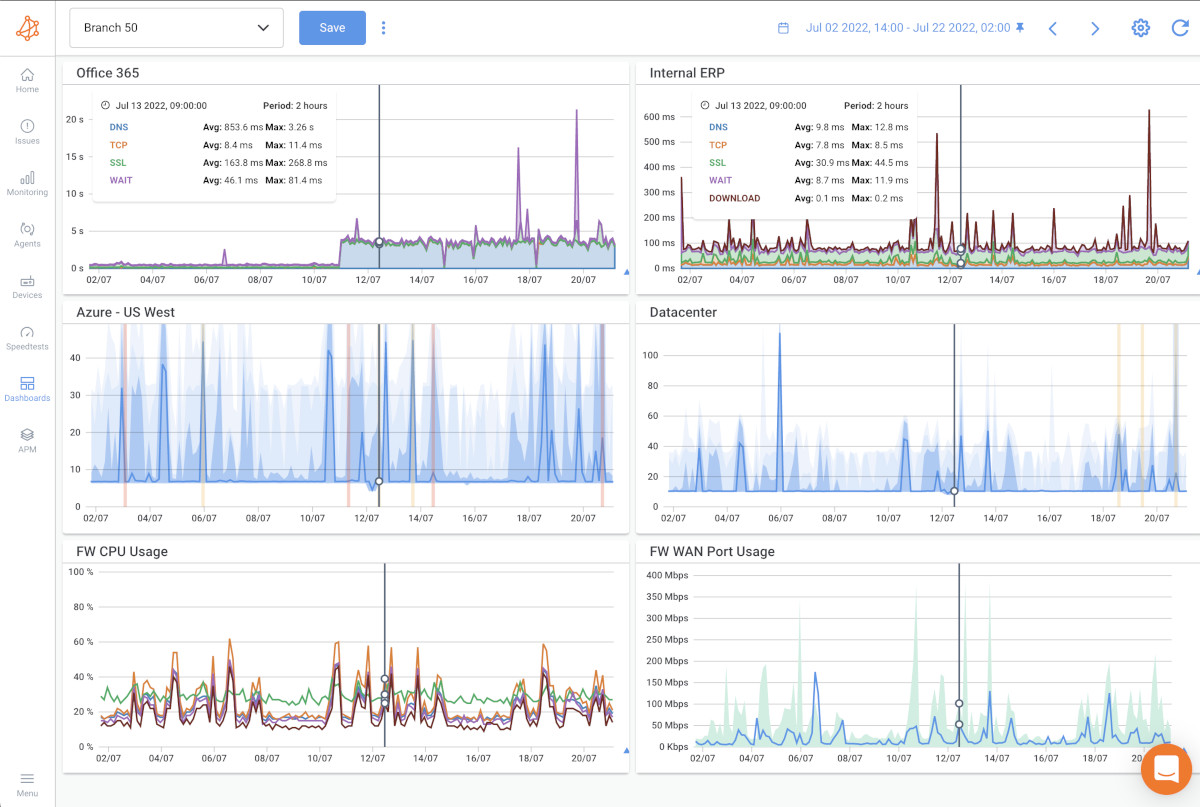
When evaluating network monitoring tools, consider the following features and capabilities:
- Real-time Monitoring: Ensure that the tool provides real-time monitoring capabilities to capture and display up-to-date network data. This allows you to respond promptly to network events and anomalies.
- Alerting and Notifications: Look for tools that offer customizable alerting and notification mechanisms. This ensures that you receive timely notifications when predefined thresholds or anomalies are detected.
- Visualization and Reporting: Effective data visualization and reporting capabilities are crucial for gaining insights from network data. Look for tools that offer customizable network monitoring dashboards, charts, graphs, and reporting options.
- Scalability: Consider the scalability of the tool to handle the size and complexity of your network infrastructure. It should be capable of collecting and processing increasing amounts of data as your network grows.
- Integration and Compatibility: Ensure that the tool can integrate with your existing systems and infrastructure. Compatibility with network devices, protocols, APIs, and third-party software enables seamless data collection and analysis.
- Ease of Use: A user-friendly interface and intuitive configuration workflows are essential for efficient monitoring. Look for tools that are easy to deploy, configure, and maintain without extensive technical expertise.
Learn how SPI Health and Safety uses Obkio to monitor network performance and troubleshoot performance issues for remote call center employees.
Learn more

Evaluate the compatibility and integration capabilities of the tools with your existing systems and infrastructure. Consider the following aspects:
- APIs and Integration Support: Check if the tool provides APIs or integration capabilities with other systems such as ticketing systems, service desk platforms, or automation frameworks. This enables seamless data exchange and workflow automation.
- Device Support: Ensure that the tool supports monitoring devices and protocols specific to your network infrastructure. Consider compatibility with routers, switches, firewalls, servers, and other critical network components.
- Data Storage and Retention: Evaluate the tool's data storage and retention capabilities. Consider factors such as storage capacity, data compression, and historical data analysis options to meet your retention and compliance requirements.
- Scalability and Performance: Assess the tool's ability to scale alongside your network. Consider performance benchmarks, the tool's ability to handle high data volumes, and its response time under various loads.
By carefully evaluating the features, capabilities, and compatibility of different network monitoring tools, you can choose the right solution that aligns with your monitoring objectives and infrastructure. In the next section, we will explore the best practices for designing an intuitive dashboard interface that effectively presents network data.
When it comes to building the perfect network monitoring dashboard from your network visiblity, it all starts with the right Network Monitoring Tool, like we talked about earlier. The right Network Monitoring tool will help you build the perfect dashboard, complete with the widgets, metrics, and information that matters to you most.
Obkio Network Monitoring is a simple SaaS solution that allows users to monitor and troubleshoot end-to-end network and application performance to identify network issues, collect network performance data, and improve the end-user experience.
Obkio leverages Network Monitoring Agents and synthetic traffic to continuously monitor network performance and identify issues. The information collected by the Agents is what you'll see in your dashboard and network monitoring graphs.

To start collecting information to build your dashboard, get started with Obkio's 14-day free trial:
- 14-day free trial of all premium features
- Deploy in just 10 minutes
- Monitor performance in all key network locations
- Measure real-time network metrics
- Identify and troubleshoot live network problems

In order to start collecting the network performance data you need to build your dashboard, you'll need help collecting that data.
To do so, Obkio uses Network Monitoring Agents deployed in key network locations (head offices, branch offices, remote locations, data centres, and more) and over the Internet. These Agents continuously exchanges synthetic traffic to proactively monitor network performance and present it to you in Obkio's App.
You can follow Obkio's Onboarding Wizard during the installation process to set this up.
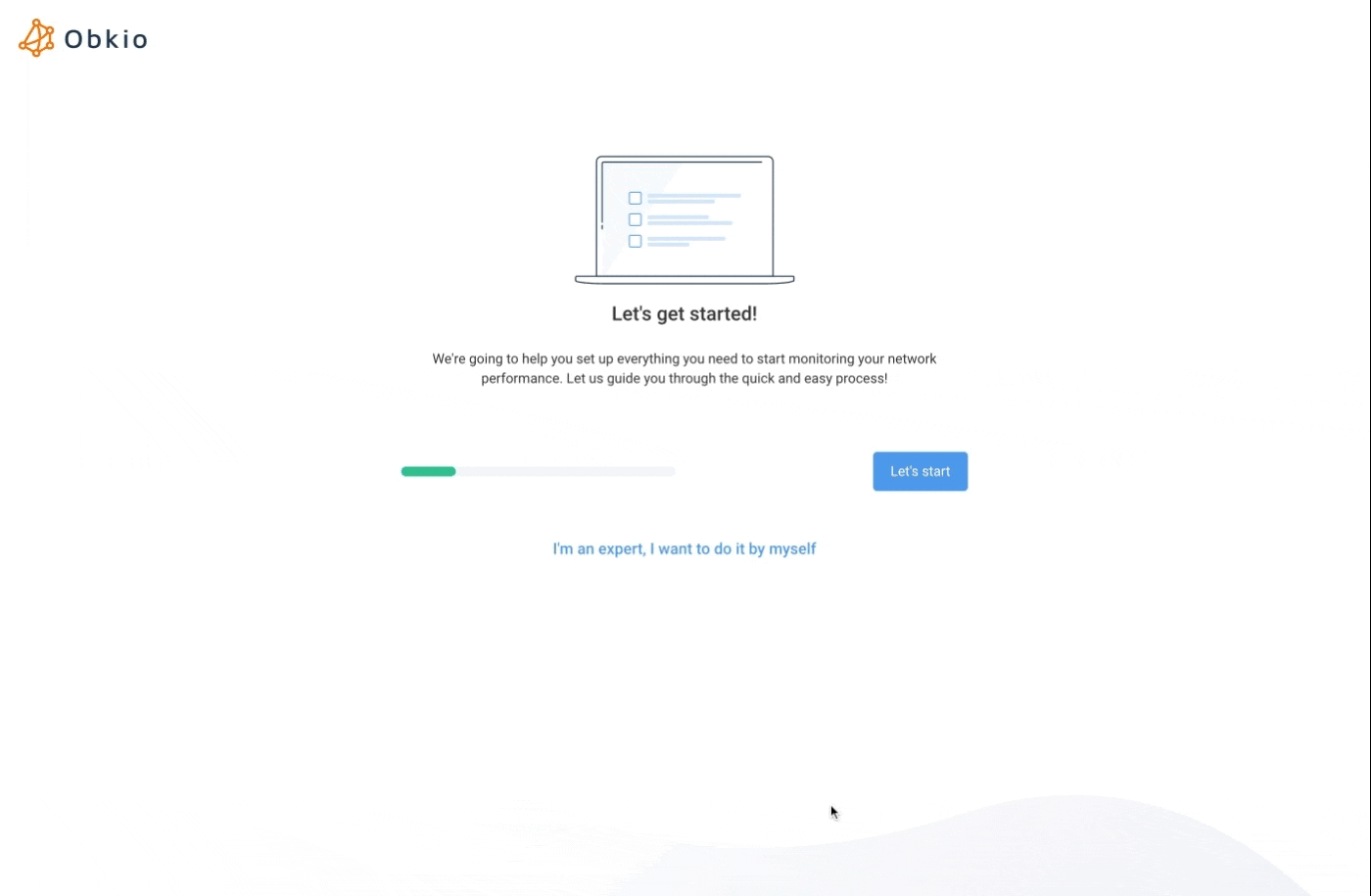
The Onboarding Wizard will help you deploy the following Monitoring Agents:
- Local Agents (Windows, MacOS, Linux, Hardware) are installed at key network locations such as branch offices, data centers, remote locations to monitor performance.
- Public Monitoring Agents are Agents installed in Service Provider networks (like AWS, Google, and Azure). They can be used to monitor the performance of any branch externally towards the Internet (without passing through the head office).
Once the Monitoring Agents are deployed, they will begin collecting information in Obkio's App. You'll begin to see this information dispalyed in Obkio's Network Performance Graphs, which you can then use to build your network monitoring dashboard.
If you're building you first dashboard, you can add your first widgets as show below. Add all the necessary widgets and then save your dashboard once you're done.
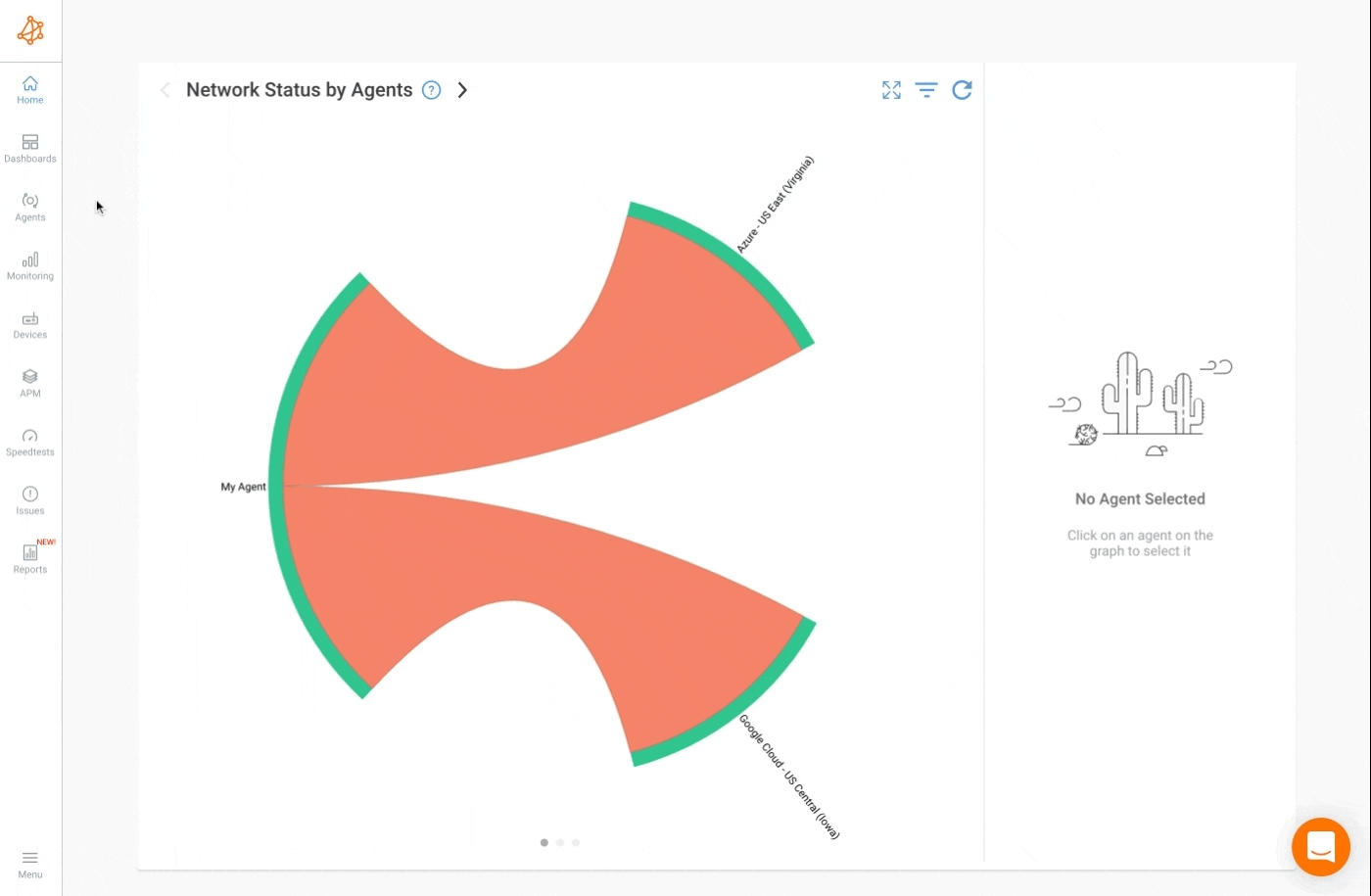
You can add any widgets you'd like by:
- Clicking on the top right gear icon
- Clicking on Add Widgets
- Selecting the type of widget
- Filling the information required and clicking on Ok
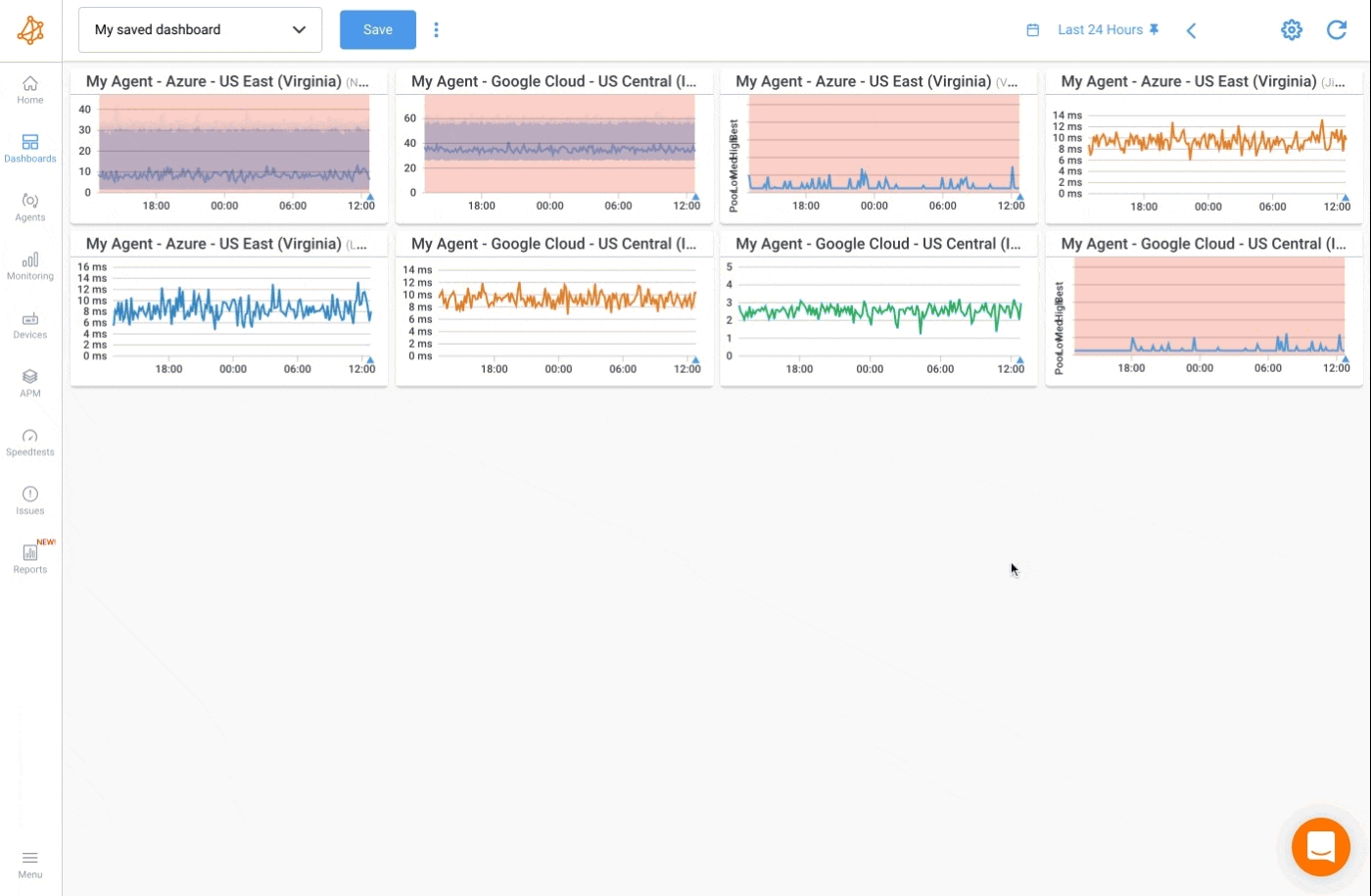
Dynamic dashboards are a way to generate a dashboard with a predefined list of widgets common to something specific. Dynamic dashboards are available, from many location in the application, via a dashboard blue icon.
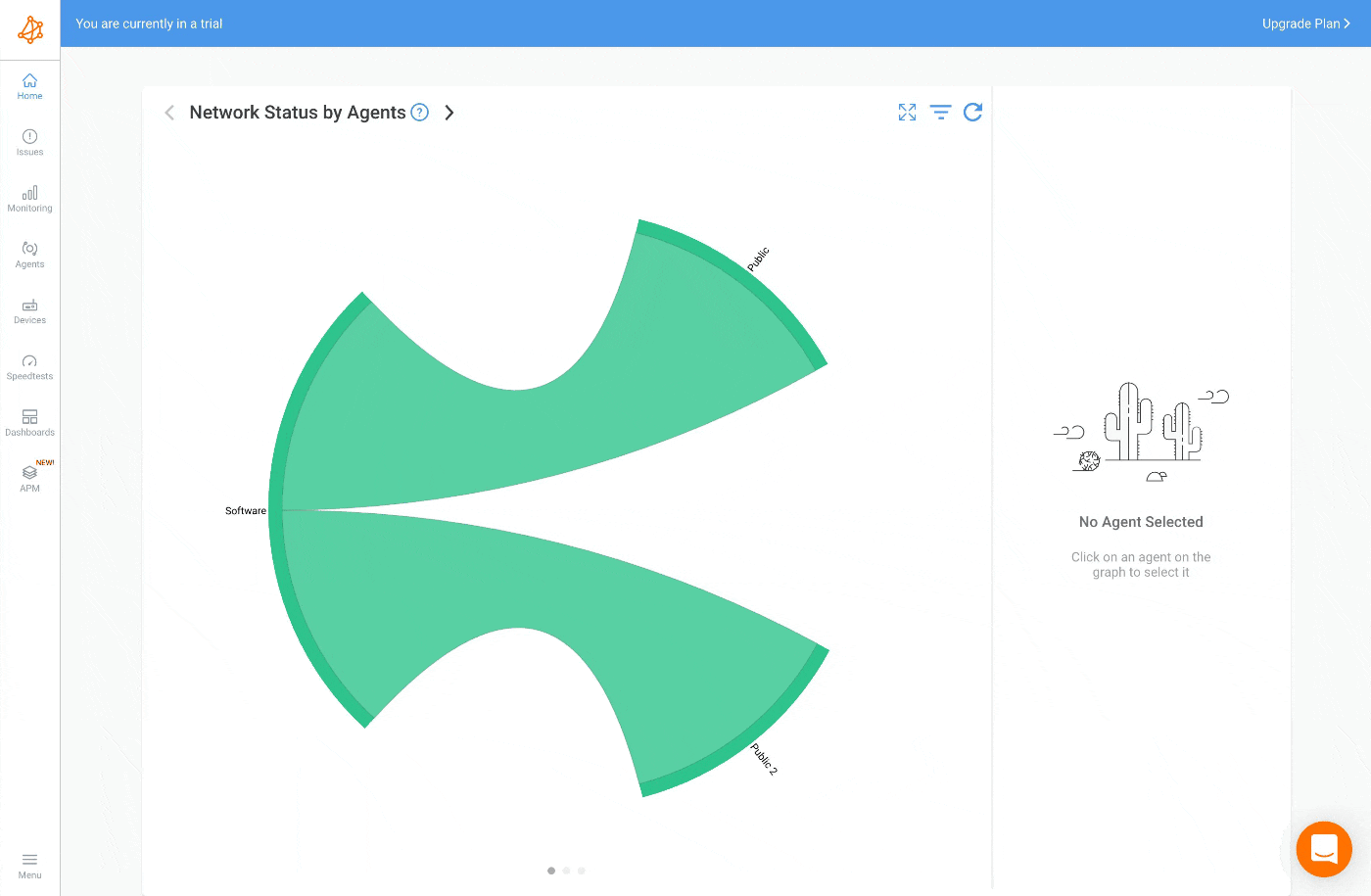
And there you have it! In just a few steps you'll have your very own network monitoring dashboard tailored to your needs. the longer Obkio keeps running, the more information you'll collect.
Check out Obkio's full Network Monitoring Dashboard Documentation to learn more about editing, managing and selecting your network monitoring dashboard.
A well-designed network monitoring dashboard is the cornerstone of effective network management. It serves as the central hub for visualizing and analyzing network data, providing insights into the health and performance of your network infrastructure. In this section, we will explore the best practices for designing an intuitive dashboard interface that effectively presents network data.
When designing your network monitoring dashboard, consider the following UI and UX best practices:
- Simplicity and Clarity: Keep the dashboard interface simple and uncluttered. Avoid overwhelming users with excessive information or unnecessary visuals. Prioritize the most critical data and present it in a clear and concise manner.
- Consistent and Intuitive Navigation: Design a dashboard with consistent navigation and labeling to ensure ease of use. Users should be able to navigate through different sections, views, or reports effortlessly. Incorporate familiar UI elements and logical grouping to enhance user understanding. Stay up-to-date with the latest web design trends to incorporate fresh ideas and techniques in your dashboard design.
- Customization Options: Provide users with customization options to tailor the dashboard to their specific needs. This may include the ability to rearrange widgets, adjust thresholds, or choose preferred data visualizations. Customizability enhances user engagement and accommodates individual preferences.
- Responsive Design: Ensure that your dashboard is responsive and accessible across different devices and screen sizes. A responsive design allows users to access and interact with the dashboard from desktops, laptops, tablets, or mobile devices, ensuring flexibility and usability.
To present network data effectively, consider the following strategies for organizing data on your dashboard:
- Grouping and Categorization: Group related metrics, devices, or applications together to provide a clear overview of different aspects of your network. Use logical categories or sections to help users quickly locate and understand relevant information.
- Hierarchy and Drill-Down Capability: Implement a hierarchical structure that allows users to drill down into specific details. Start with high-level summary information and enable users to access more granular data by interacting with widgets or clicking on specific elements.
- Prioritization and Contextualization: Prioritize critical metrics and data that align with your monitoring objectives. Use visual cues such as color-coding, icons, or alert indicators to highlight important information. Provide contextual information or tooltips to help users understand the significance of the presented data.
- Historical Trends and Historical Comparison: Incorporate historical trend analysis and comparison features to allow users to assess network performance over time. Visualize historical data with charts or graphs to identify patterns, anomalies, or recurring issues.
Effective data visualization is key to understanding complex network information. Consider the following best practices for visualizing data on your dashboard:
- Clear and Concise Visualizations: Use clear and concise visualizations, such as line charts, bar charts, or gauges, to represent data. Avoid cluttering the dashboard with unnecessary visuals or overwhelming users with too many data points.
- Color Usage: Utilize colors purposefully to convey meaning and differentiate data elements. Use a consistent color scheme and consider color-blind accessibility. Ensure that colors are not too vibrant or overwhelming.
- Widgets and Key Performance Indicators (KPIs): Incorporate widgets or KPIs to provide at-a-glance information about critical network metrics. Widgets can include summary statistics, real-time status indicators, or performance summaries.
- Contextual Alerts and Notifications: Integrate contextual network monitoring alerts and notifications within the visualizations to draw attention to anomalies or critical events. Use visual cues such as color changes, icons, or text formatting to indicate alert status.
A network monitoring dashboard should provide a comprehensive overview of your network's health and performance. Here are network dashboard examples of elements, metrics, and widgets you should have on a network monitoring dashboard:
Real-Time Status: Display the real-time status of critical network devices and services, including routers, switches, servers, and applications. Use color-coded indicators (green for healthy, yellow for warning, red for critical) for quick status checks.
Network Traffic: Monitor inbound and outbound network traffic volumes, bandwidth utilization, and throughput rates. Visualize traffic trends and spikes to identify potential congestion or performance issues.
Latency and Response Times: Track latency metrics, such as round-trip times (RTT) and response times, for key network paths and devices. Set thresholds to alert for excessive delays that may impact user experience.
Packet Loss: Monitor packet loss rates across network segments and connections. Identify sources of packet loss and take proactive measures to address underlying issues.
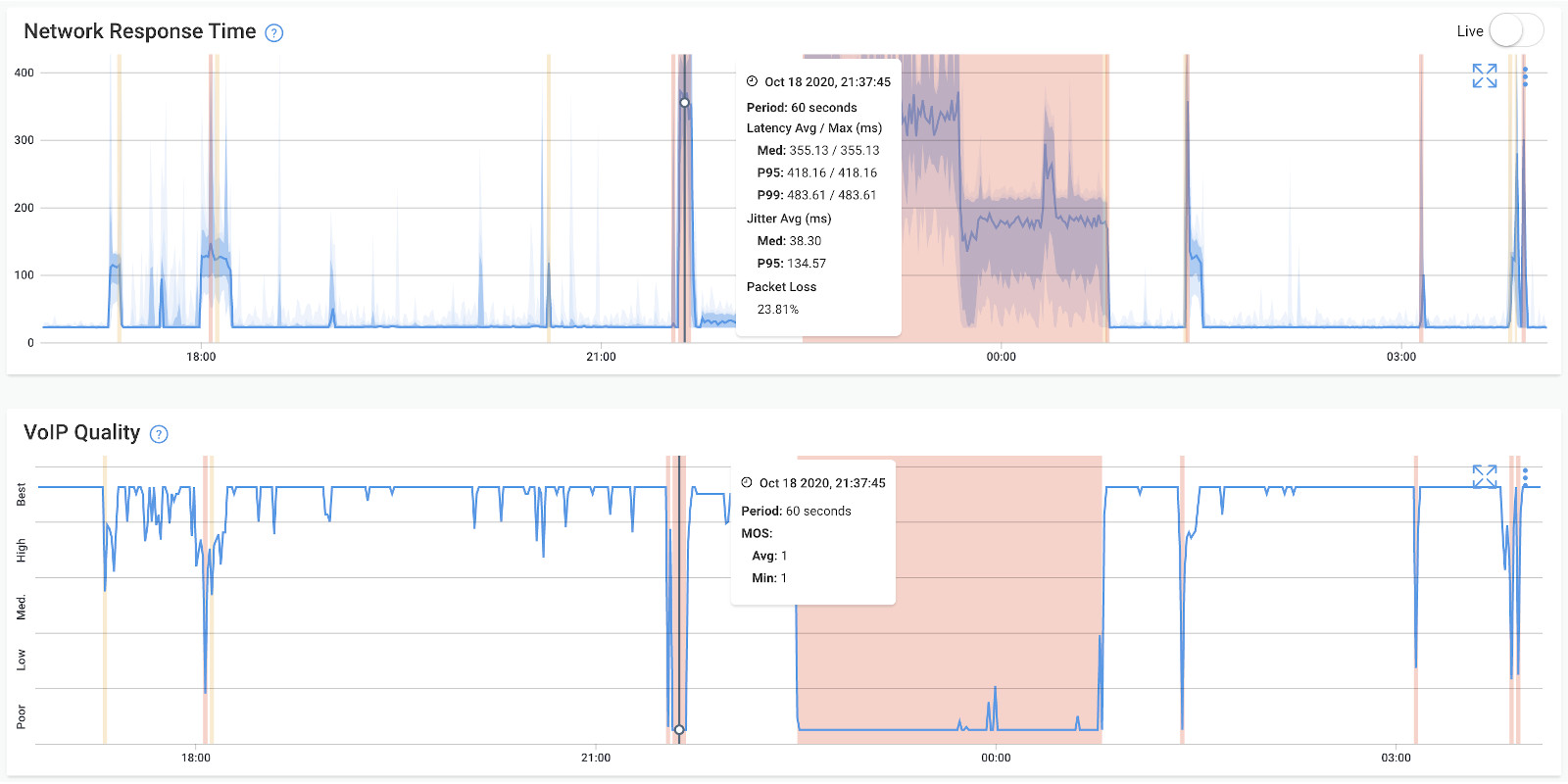
Device Health Metrics: Monitor CPU utilization, memory usage, disk space, and other performance metrics for network devices. Detect anomalies or resource bottlenecks that could affect device functionality.
Security Events: Display security events, intrusion attempts, and anomalies detected by firewalls, intrusion detection systems (IDS), and antivirus solutions. Monitor for suspicious activities and potential threats.
Service Availability: Track the availability and uptime of critical services, such as email servers, databases, and web applications. Set alerts for service outages or performance degradation.
Alerts and Notifications: Configure alerts and notifications for network events, performance thresholds, and security incidents. Ensure alerts are actionable and prioritize based on severity levels.
Historical Data and Trends: Provide historical data and trend analysis for network performance metrics. Identify long-term patterns, forecast future trends, and plan capacity upgrades or optimizations.
User Experience Monitoring: Include user experience monitoring for applications and services accessed by end-users. Measure response times, transaction completion rates, and user satisfaction scores.

Geographical Views: Use geographical maps or visualizations to depict network topology, traffic flows, and device locations. Identify geographical trends and optimize routing for global networks.
Compliance and Auditing: Include compliance reports, audit logs, and regulatory compliance checks. Ensure network monitoring aligns with industry standards and regulatory requirements.
By incorporating these elements into your network monitoring dashboard, you can gain actionable insights, proactively address issues, and optimize network performance and reliability.
By following these UI, UX, and data visualization best practices, you can create an intuitive dashboard interface that empowers users to monitor and understand network data effectively. In the next section, we will explore the process of configuring data collection and analysis for your network monitoring dashboard.
Configuring data collection and analysis is a crucial step in building an effective network monitoring dashboard.
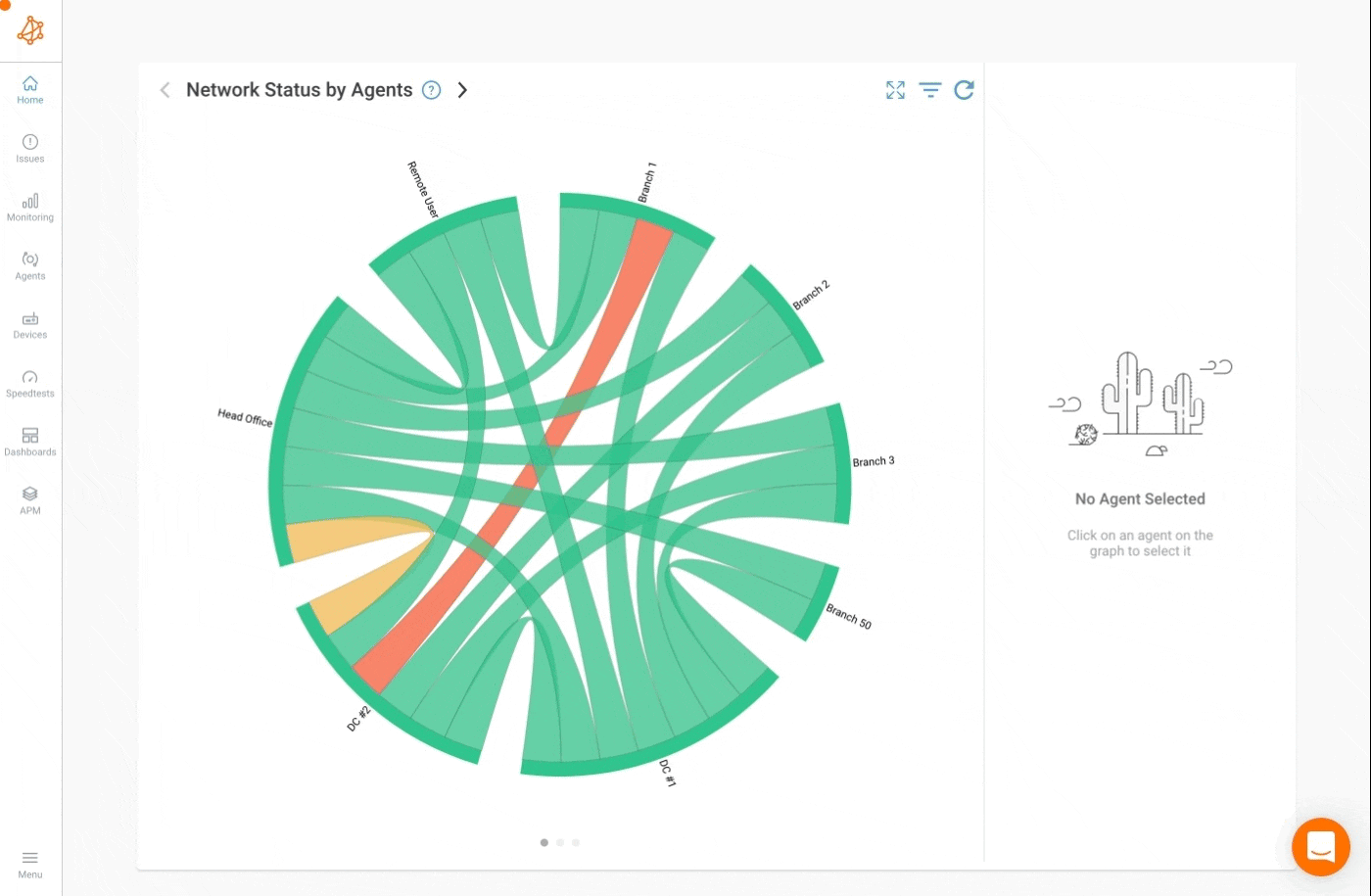
It involves setting up the necessary components to collect network data, defining thresholds and alerts, and implementing data analysis techniques.
In this section, we will explore the process of configuring data collection and analysis for your network monitoring dashboard.
To collect network data for your monitoring dashboard, consider the following steps:
- Identify Key Data Sources: Determine the network devices, servers, applications, or protocols from which you need to collect data. This may include routers, switches, firewalls, servers, or SNMP-enabled devices. Consider the metrics and data points you identified during the goal-setting phase.
- Select Network Monitoring Methods: Choose appropriate monitoring methods for each data source. This can include SNMP network monitoring (Simple Network Management Protocol), NetFlow, packet capture, or API-based data retrieval. Each method has its own benefits and considerations, so choose the one that aligns with your monitoring objectives and infrastructure.
- Implement Data Collection Agents or Sensors: Deploy data collection agents or sensors on the identified data sources. These agents or sensors are responsible for gathering and transmitting data to your monitoring system. Ensure that they are properly installed and configured to collect the relevant data accurately.
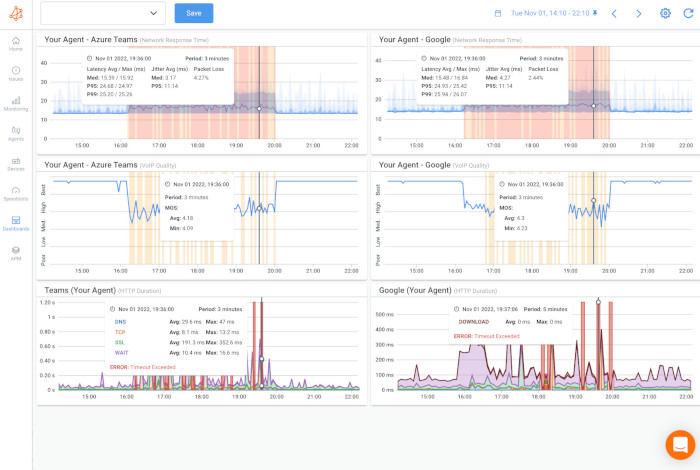
Defining thresholds and alerts helps you proactively monitor network performance and detect anomalies. Consider the following steps:
- Determine Threshold Values: Set threshold values for critical metrics based on your performance expectations and objectives. Thresholds can be defined for metrics like bandwidth utilization, latency, packet loss, CPU usage, or any other key indicators. These values represent the upper or lower limits beyond which an alert should be triggered.
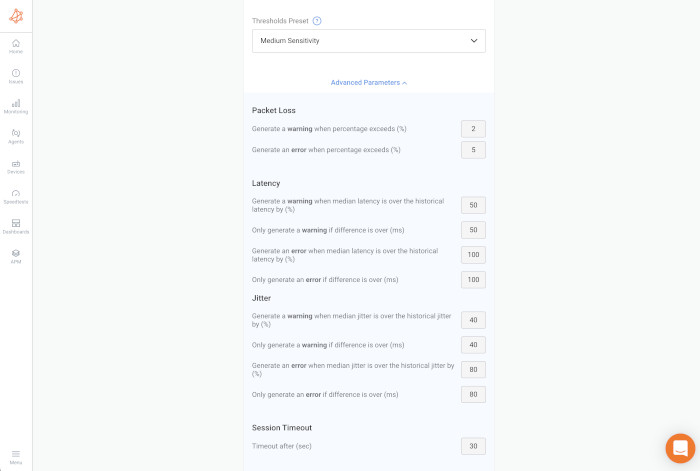
- Configure Alerting Mechanisms: Choose the appropriate alerting mechanisms for your network monitoring dashboard. This can include email notifications, SMS alerts, or integration with incident management or ticketing systems. Ensure that alerts are sent to the relevant stakeholders promptly when thresholds are breached.
- Prioritize and Fine-Tune Alerts: Prioritize alerts based on their severity and impact on network performance. Fine-tune alert conditions and thresholds to minimize false positives or false negatives. Regularly review and refine alerting rules to align with changing network conditions and performance requirements.
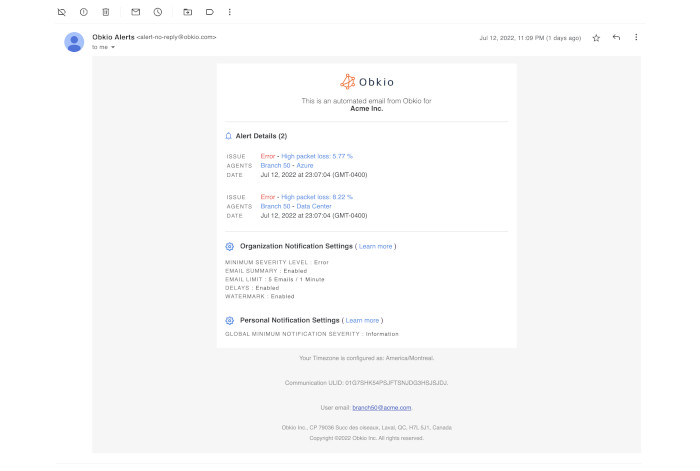
Data analysis techniques help uncover patterns, trends, or anomalies in network data. Consider the following practices:
- Data Aggregation and Granularity: Determine the level of data aggregation and granularity required for your analysis. Aggregating data over specific time intervals (e.g., hourly, daily) can help identify long-term trends, while granular data can reveal short-term fluctuations or anomalies.
- Statistical Analysis: Utilize statistical analysis techniques to identify patterns or abnormalities in network data. This can include calculating averages, standard deviations, or percentiles to understand data distribution and identify outliers.
- Anomaly Detection Methods: Implement anomaly detection algorithms to identify unusual behavior or deviations from normal network patterns. This can include statistical methods, machine learning algorithms, or rule-based approaches. Fine-tune anomaly detection algorithms to reduce false positives and ensure accurate identification of anomalies.
- Correlation and Root Cause Analysis: Explore correlation techniques to identify relationships between different network metrics or events. This can help in root cause analysis and troubleshooting by understanding how different factors impact network performance.
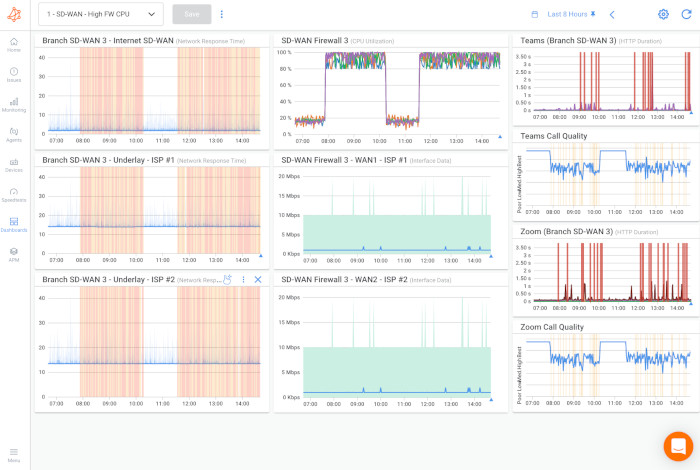
By configuring data collection and analysis effectively, you ensure that your network monitoring dashboard receives accurate and timely data, detects anomalies, and provides meaningful insights. In the next section, we will explore the importance of real-time monitoring and its implementation in your network monitoring dashboard.
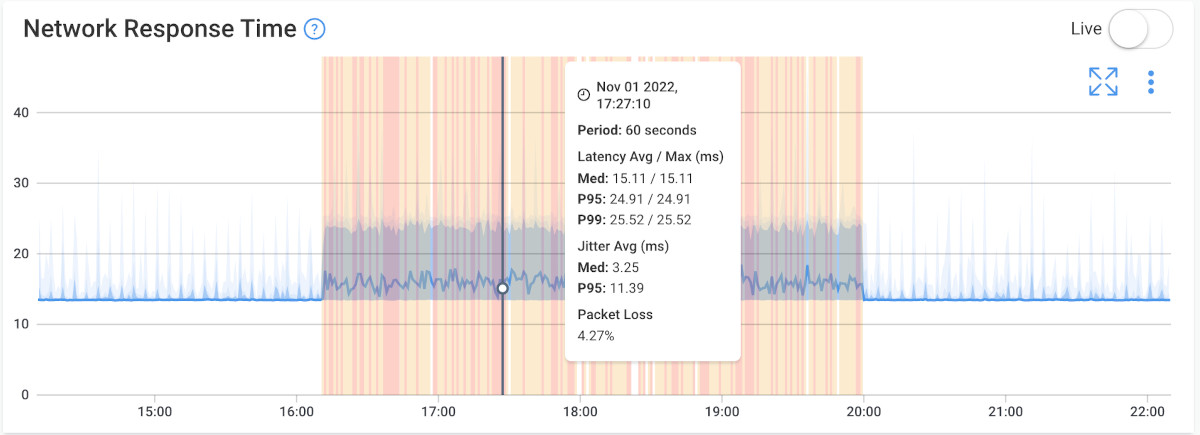
Section 8: Implementing Real-Time Network Monitoring To Collect Data For Your Network Monitoring Dashboard
Real-time monitoring is a critical aspect of network management, allowing you to promptly detect and respond to network issues or anomalies.
By implementing real-time monitoring in your network monitoring dashboard, you can ensure that you have up-to-the-minute insights into your network's performance.
In this section, we will explore the importance of real-time monitoring and its implementation in your network monitoring dashboard.
Real-time monitoring offers several key benefits for network management:
- Prompt Issue Detection: Real-time monitoring enables the immediate detection of network issues or anomalies as they occur. By capturing and analyzing data in real-time, you can identify and address problems before they escalate, minimizing their impact on network performance and user experience.
- Rapid Incident Response: With real-time monitoring, you can respond to incidents quickly and effectively. When an alert is triggered or a performance metric exceeds predefined thresholds, you receive immediate notifications. This allows you to initiate troubleshooting, investigate the root cause, and take corrective actions promptly.
- Proactive Performance Optimization: Real-time monitoring provides the ability to proactively optimize network performance. By continuously monitoring key metrics, you can identify performance bottlenecks, network capacity limitations, or network congestion in real-time. This empowers you to take proactive steps to optimize resource allocation and enhance overall network efficiency.
- Enhanced User Experience: Real-time monitoring helps ensure a positive user experience by detecting and addressing issues that can impact network performance. By promptly identifying and resolving network-related problems, you can minimize service disruptions, improve application response times, and deliver a reliable and responsive network experience to your users.
To implement real-time monitoring in your network monitoring dashboard, consider the following steps:
- Real-Time Data Ingestion: Ensure that your dashboard is capable of ingesting and processing real-time data from various sources. This may involve utilizing streaming technologies, such as message queues or event-driven architectures, to capture and handle data as it is generated.
- Live Visualization and Updates: Design your dashboard to provide live visualization and updates of critical metrics. Display real-time charts, graphs, or performance indicators that update dynamically as new data is received. This allows users to monitor the network in real-time and react swiftly to changing conditions.
- Immediate Alerting and Notifications: Configure your dashboard to generate immediate alerts and notifications when predefined thresholds are breached or anomalies occur. Users should receive real-time notifications through email, SMS, or dashboard alerts to ensure prompt awareness of critical events.
- Interactive Monitoring and Drill-Down Capabilities: Enable interactive monitoring capabilities in your dashboard. Users should be able to interact with visualizations, explore additional details, and drill down into specific data points for deeper analysis. This empowers them to investigate issues and uncover insights in real-time.
- Performance Monitoring Dashboards: Consider implementing specialized performance monitoring dashboards that focus on real-time metrics for critical applications, services, or specific network segments. These dashboards provide a dedicated view of real-time performance and help ensure focused monitoring of crucial aspects of your network.

By incorporating real-time monitoring capabilities into your network monitoring dashboard, you equip yourself with the tools necessary to detect, analyze, and respond to network events as they happen. In the next section, we will explore the best practices for optimizing performance and scalability in your network monitoring dashboard.
Optimizing the performance and scalability of your network monitoring dashboard is crucial for handling increasing data volumes, ensuring efficient operations, and providing a seamless user experience. In this section, we will explore the best practices for optimizing performance and scalability in your network monitoring dashboard.
As your network grows in size and complexity, it's important to scale your monitoring dashboard to accommodate the expanding requirements. Consider the following practices:
- Distributed Network Architecture: Implement a distributed architecture for your dashboard to distribute the workload across multiple servers or nodes. This allows for better resource utilization, improved data processing, and increased scalability.
- Load Balancing: Utilize load balancing techniques to evenly distribute incoming requests or data across multiple instances of your monitoring dashboard. This helps prevent performance bottlenecks and ensures efficient utilization of available resources.
- Horizontal Scaling: Consider horizontal scaling by adding additional monitoring instances to handle increased data volumes and user traffic. This involves adding more servers or nodes to your monitoring infrastructure to share the workload and improve performance.
- Database Optimization: Optimize the database that stores your monitoring data to improve query performance and reduce response times. Techniques such as indexing, query optimization, and data partitioning can significantly enhance the overall performance of your dashboard.

Learn how to monitor distributed networks like SD-WAN using Obkio’s distributed Network Performance Monitoring tool vs. traditional centralized solutions.
Learn more

To optimize the performance of your network monitoring dashboard, consider the following techniques:
- Data Aggregation and Sampling: Implement data aggregation and sampling methods to reduce the volume of data processed and stored. Aggregating data over specific time intervals or sampling data at regular intervals can help maintain performance while still providing meaningful insights.
- Caching and In-Memory Data Storage: Utilize caching mechanisms and in-memory data storage to accelerate data retrieval and reduce database load. Caching commonly accessed data or utilizing in-memory databases can significantly improve dashboard responsiveness.
- Asynchronous Processing: Employ asynchronous processing for resource-intensive tasks or data operations. By offloading time-consuming tasks to background processes or separate threads, you can ensure that the dashboard remains responsive and doesn't experience performance degradation.
- Query Optimization: Optimize database queries used for retrieving monitoring data. Ensure that queries are well-structured, utilize appropriate indexes, and avoid unnecessary joins or resource-intensive operations. Regularly monitor and fine-tune query performance to maintain optimal dashboard responsiveness.
Data accuracy and reliability are paramount for an effective network monitoring dashboard. Consider the following practices:
- Data Validation and Cleansing: Implement data validation mechanisms to ensure the accuracy and integrity of incoming data. Validate data against predefined rules, perform error checking, and cleanse data to remove inconsistencies or invalid entries.
- Redundancy and Failover: Implement redundancy and network failover mechanisms to ensure the availability and reliability of your dashboard. Utilize redundant servers, load balancers, or backup instances to minimize the impact of hardware failures or network outages.
- Data Backup and Disaster Recovery: Regularly back up your monitoring data and implement disaster recovery plans. This helps protect against data loss, system failures, or natural disasters, ensuring that critical network information is recoverable in case of unforeseen events.
- Regular Maintenance and Monitoring: Conduct regular maintenance and monitoring of your monitoring infrastructure. Monitor the health and performance of servers, databases, and network components to identify and address any potential issues proactively.
By implementing performance optimization techniques, scaling your network monitoring dashboard, and ensuring data accuracy and reliability, you can maintain an efficient and robust monitoring environment.
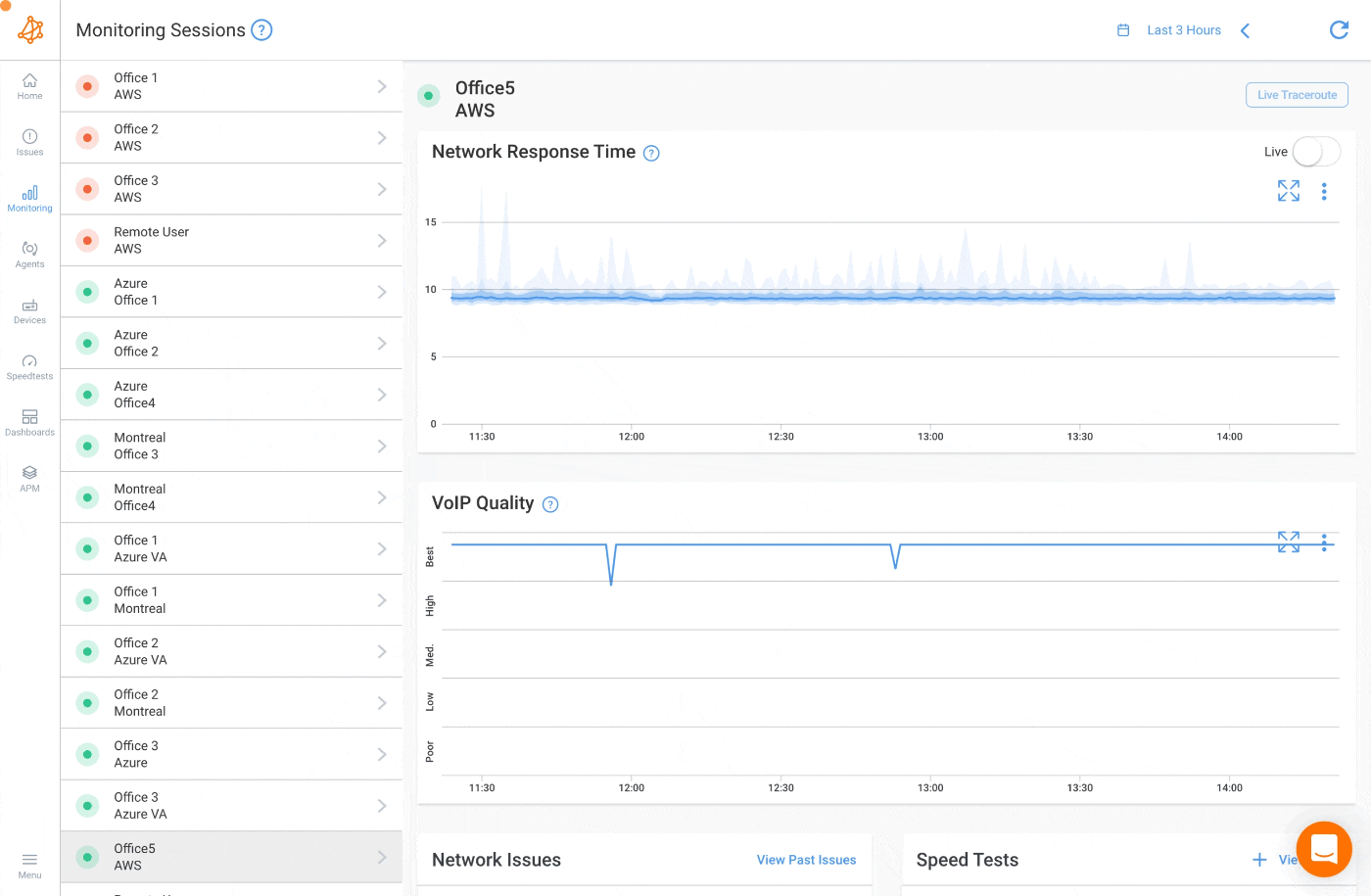
In the next section, we will explore the benefits and considerations of integrating automation and artificial intelligence (AI) in your network monitoring dashboard.
Automation and artificial intelligence (AI) can revolutionize network monitoring by streamlining workflows, providing intelligent insights, and enhancing overall efficiency. In this section, we will explore the benefits and considerations of integrating automation and AI in your network monitoring dashboard.
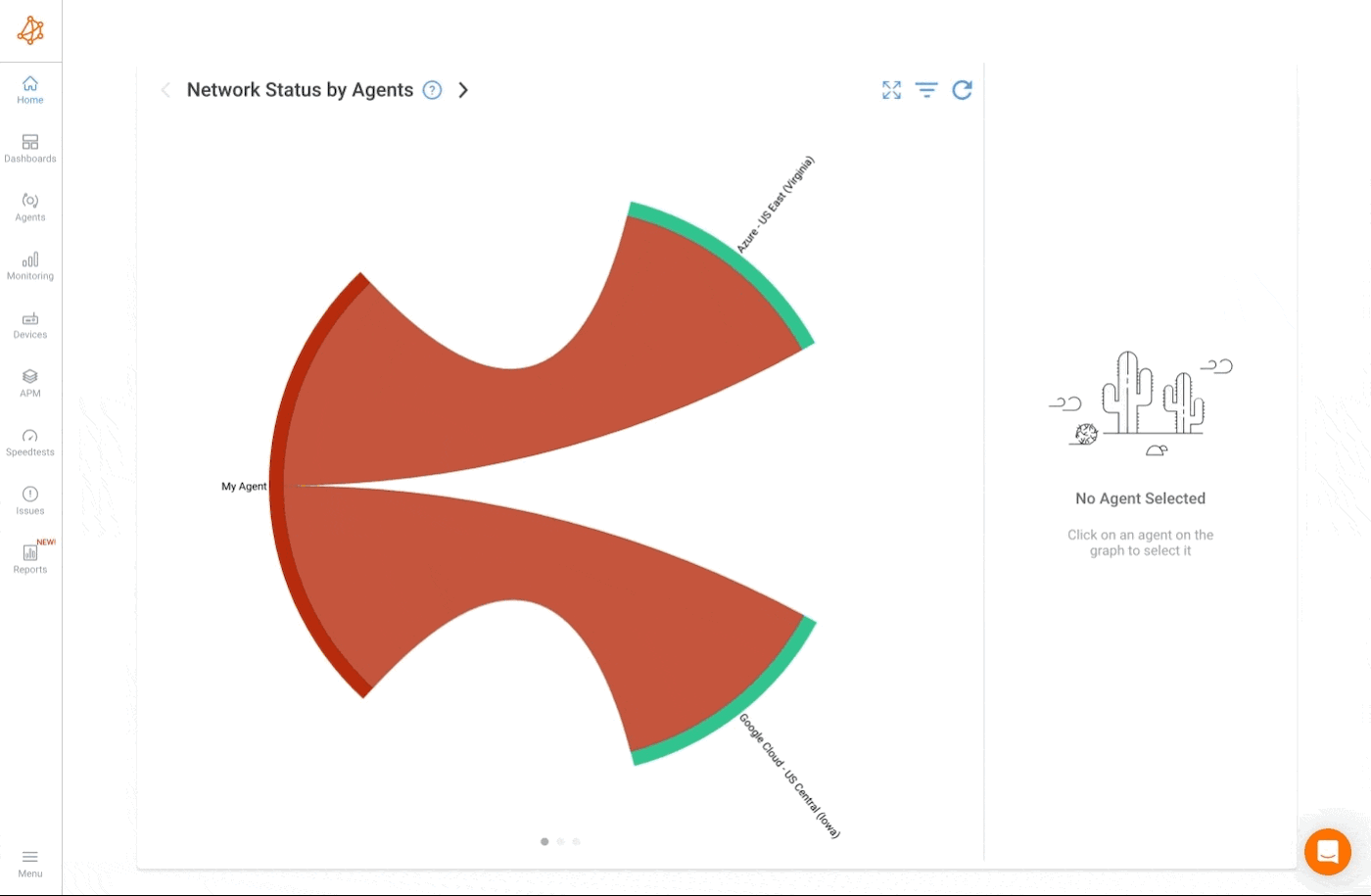
Integrating automation and AI into your network monitoring dashboard offers several advantages:
- Efficient Workflow Automation: Automation simplifies repetitive and time-consuming tasks, allowing your team to focus on strategic initiatives. By automating routine monitoring tasks, data collection, or report generation, you can reduce manual effort, improve productivity, and allocate resources more effectively. LLM agents can improve this process by quickly adapting to new tasks and improving automation efficiency.
- Intelligent Alerting and Incident Response: AI-powered algorithms can analyze vast amounts of network data in real-time, identifying patterns, anomalies, or potential issues that may go unnoticed by manual monitoring. By leveraging AI for intelligent alerting and incident response, you can improve the accuracy of notifications and streamline troubleshooting processes.
- Predictive Analytics and Proactive Maintenance: AI techniques, such as machine learning, enable predictive analytics by analyzing historical data and identifying trends or patterns. This empowers you to predict potential network issues, plan for future capacity requirements, and proactively perform maintenance activities to prevent downtime or performance degradation.
- Enhanced Root Cause Analysis: AI algorithms can help in root cause analysis by correlating multiple data sources and identifying the underlying causes of network issues. This accelerates troubleshooting efforts and enables faster resolution of incidents, minimizing the impact on network performance and user experience.

While automation and AI integration offer numerous benefits, it's important to consider the following aspects:
- Data Quality and Training: The accuracy and quality of data used for AI algorithms play a crucial role in the effectiveness of automation and AI-driven insights. Ensure that your data is clean, consistent, and properly labeled for training AI models. Regularly validate and update your data to maintain its relevance and accuracy.
- Ethical and Transparent AI: Transparency and ethical considerations are vital when integrating AI into your monitoring dashboard. Understand how AI algorithms make decisions and ensure transparency in how they process and interpret data. Consider potential biases or ethical concerns that may arise and address them appropriately.
- Human Oversight and Expertise: While automation and AI can streamline processes, human oversight and expertise are still essential. Maintain a balance between automated tasks and human involvement to ensure critical thinking, problem-solving, and decision-making capabilities.
- Continuous Learning and Adaptation: AI models require ongoing training and adaptation to stay relevant and effective. Regularly update and retrain your AI models as your network evolves, new data patterns emerge, or the monitoring environment changes. Stay informed about emerging AI technologies and advancements to leverage the latest innovations in your network monitoring practices.
By integrating automation and AI into your network monitoring dashboard, you can optimize workflows, gain intelligent insights, and proactively manage your network infrastructure. In the next section, we will explore the importance of ensuring security and privacy in your network monitoring dashboard.
Security and privacy are paramount considerations when building a network monitoring dashboard.
Safeguarding sensitive data, protecting against unauthorized access, and complying with regulations are essential for maintaining a secure and trusted monitoring environment.
In this section, we will explore the importance of ensuring security and privacy in your network monitoring dashboard.
To ensure the security of data transmission and storage in your network monitoring dashboard, consider the following practices:
- Encrypted Data Transmission: Use secure protocols, such as HTTPS or SSH, for data transmission between network devices, agents, and the monitoring dashboard. Encryption ensures that data remains confidential during transit, protecting it from interception or unauthorized access.
- Secure Authentication: Implement strong authentication mechanisms to control access to your monitoring dashboard. Utilize multi-factor authentication (MFA) or strong password policies to prevent unauthorized login attempts and protect user accounts.
- Role-Based Access Control: Define user roles and assign appropriate access levels based on job responsibilities. Grant access only to the necessary data and functionalities required for each user's role. Regularly review and update access permissions to align with organizational changes.
- Data Encryption at Rest: Encrypt sensitive data stored in your monitoring dashboard's database or storage systems. This provides an additional layer of protection in case of unauthorized access to the underlying infrastructure.
To protect sensitive information in your network monitoring dashboard, consider the following measures:
- Anonymization and Masking: When storing or displaying data, anonymize or mask personally identifiable information (PII) and sensitive details. Replace sensitive data with placeholders or hashes to prevent unauthorized exposure of personal or confidential information.
- Secure Configuration and Hardening: Follow secure configuration practices for the underlying infrastructure, servers, and operating systems. Apply necessary security patches, disable unnecessary services, and employ strong firewall rules to minimize potential vulnerabilities.
- Audit Logs and Monitoring: Enable auditing and logging mechanisms to track user activities, system events, and access attempts. Regularly review audit logs to detect and investigate any suspicious activities or potential security breaches.
- Regular Vulnerability Assessments: Conduct regular vulnerability assessments and penetration testing of your monitoring infrastructure. Identify and address security weaknesses, misconfigurations, or vulnerabilities that could be exploited by malicious actors.
Ensure that your network monitoring dashboard complies with relevant regulations and standards. Consider the following practices:
- Data Privacy Regulations: Comply with data privacy regulations, such as the General Data Protection Regulation (GDPR) or the California Consumer Privacy Act (CCPA). Understand the requirements for data collection, storage, and user consent, and ensure that your monitoring practices align with these regulations.
- Industry-Specific Compliance: If operating in regulated industries such as healthcare or finance, understand and comply with specific industry standards, such as the Health Insurance Portability and Accountability Act (HIPAA) or the Payment Card Industry Data Security Standard (PCI DSS). Implement necessary controls and safeguards to protect sensitive information.
- Data Retention Policies: Establish data retention policies that align with regulatory requirements and business needs. Clearly define the duration for which monitoring data should be retained, ensuring compliance with data privacy regulations and any legal obligations.
- Regular Security Assessments: Conduct periodic security assessments, network risk assessments and audits to evaluate the effectiveness of your security measures and identify areas for improvement. Engage external security experts if necessary to perform independent assessments and validate your security practices.
By prioritizing security and privacy considerations, you can build a network monitoring dashboard that protects sensitive information, maintains data integrity, and complies with relevant regulations. In the next section, we will discuss the importance of ongoing monitoring and continuous improvement for your network monitoring dashboard.
Building an effective network monitoring dashboard is an ongoing process that requires regular monitoring, evaluation, and continuous improvement.
By consistently assessing the performance of your dashboard, identifying areas for enhancement, and adapting to evolving network requirements, you can ensure that your monitoring practices remain effective and aligned with your business objectives.
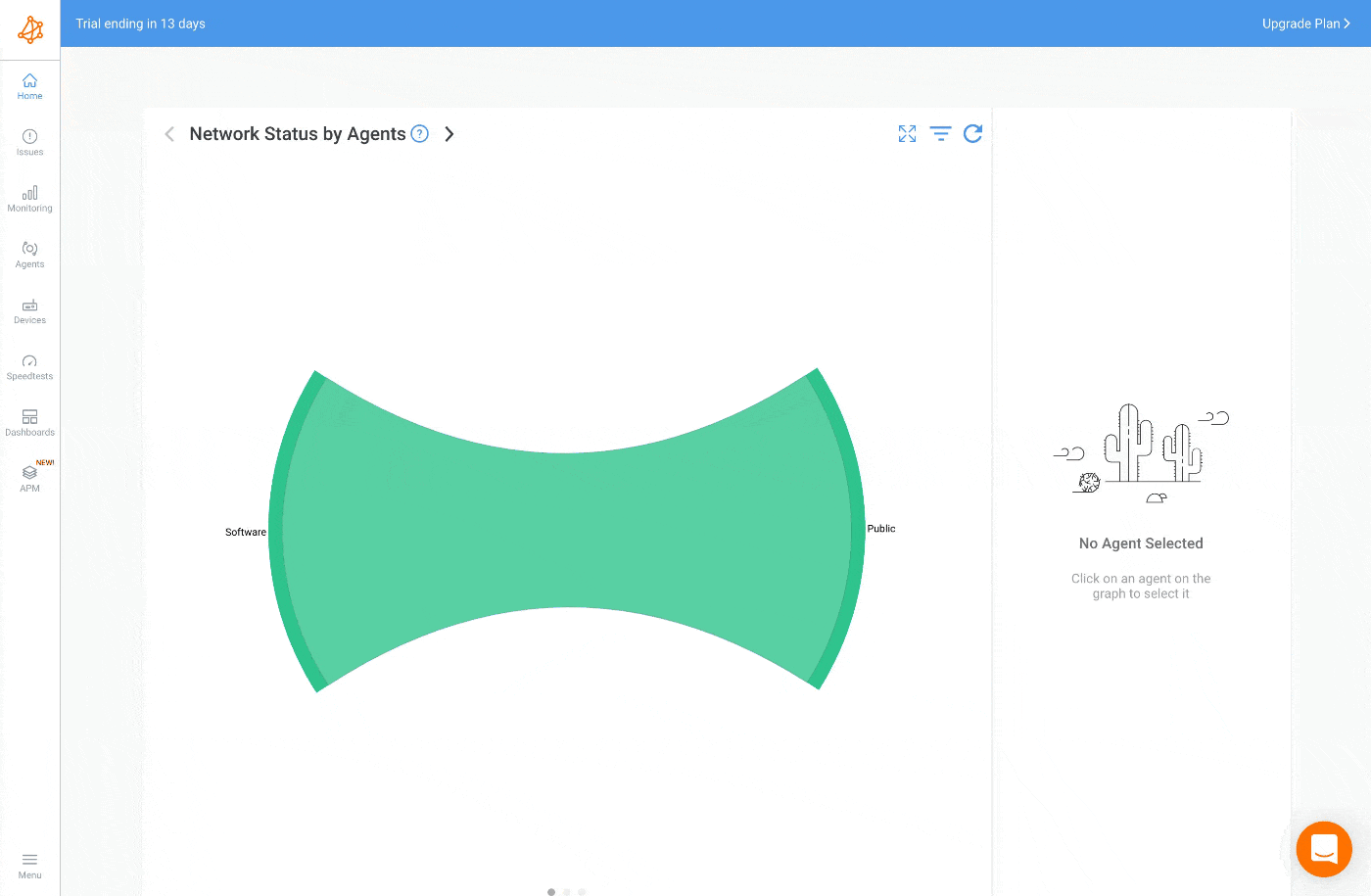
In this section, we will explore the importance of ongoing monitoring and continuous improvement for your network monitoring dashboard.
Regular monitoring and evaluation help gauge the effectiveness of your network monitoring dashboard and identify areas for improvement. Consider the following practices.
- Key Performance Indicators (KPIs): Define KPIs to measure the performance and efficiency of your monitoring dashboard. This may include metrics such as data accuracy, responsiveness, uptime, or user satisfaction. Regularly monitor and analyze these KPIs to assess the overall performance of your dashboard.
- User Feedback and Satisfaction: Seek feedback from users of the monitoring dashboard to understand their experiences, challenges, and suggestions for improvement. Conduct surveys, user interviews, or focus groups to gather valuable insights that can guide your continuous improvement efforts.
- Incident and Problem Analysis: Analyze incidents, problems, or network outages to identify any gaps or shortcomings in your monitoring practices. Assess whether the dashboard provided sufficient visibility or early warning signs for the incidents and determine if any enhancements are required.
- Performance Baselines: Establish network performance baselines for critical metrics and continuously compare the actual performance of your monitoring dashboard against these baselines. Deviations from baselines can indicate potential issues or areas that need attention.
Based on the findings from regular monitoring and evaluation, initiate continuous improvement efforts for your network monitoring dashboard. Consider the following practices:
- Dashboard Optimization: Refine the design and layout of your dashboard based on user feedback and evolving requirements. Incorporate new widgets, rearrange existing elements, or introduce new network visualization techniques to enhance the dashboard's usability and visual appeal.
- Alerting and Threshold Refinement: Fine-tune alerting mechanisms, threshold values, or notification policies based on the analysis of incidents and user feedback. Adjust thresholds to minimize false positives or negatives, and optimize alerting rules to ensure timely and accurate notifications.
- Automation and Scripting: Identify opportunities for automation and scripting to streamline monitoring processes, data collection, or routine tasks. Automate repetitive workflows, implement self-healing mechanisms, or leverage scripting to enhance efficiency and reduce manual effort.
- Training and Skill Development: Provide training and skill development opportunities for your monitoring team. Keep them updated with the latest monitoring technologies, best practices, and industry trends. This empowers them to leverage new features, optimize configurations, and continuously improve their monitoring expertise.
Network environments are dynamic and subject to constant changes. Stay agile and adaptable by regularly assessing and adjusting your network monitoring practices. Consider the following practices:
- Stay Informed: Stay abreast of emerging technologies, industry trends, and advancements in network monitoring practices. Engage in professional communities, attend conferences, or participate in webinars to keep up with the latest developments.
- Flexibility in Dashboard Design: Design your dashboard with flexibility in mind, allowing for easy customization and adaptation. Incorporate modular components or flexible layouts that can accommodate future changes in data sources, metrics, or user requirements.
- Embrace New Technologies: Continuously evaluate new technologies and tools that can enhance your network monitoring practices. Consider the adoption of machine learning, artificial intelligence, or advanced analytics to gain deeper insights into network behavior and improve predictive capabilities.
By prioritizing ongoing monitoring, continuous improvement, and adaptability, you can ensure that your network monitoring dashboard remains effective and aligned with your evolving business needs. In the final section, we will summarize the key takeaways from this guide and highlight the importance of a well-designed and optimized network monitoring dashboard.
Explore essential network monitoring best practices for network admins, from choosing the right tools to troubleshooting internal and external issues.
Learn more

Building an effective network monitoring dashboard is crucial for ensuring the optimal performance, availability, and security of your network infrastructure. A well-designed and optimized dashboard provides real-time visibility into network data, facilitates proactive monitoring and incident response, and empowers you to make informed decisions for network management and optimization. In this guide, we have explored the key components, considerations, and best practices involved in building an effective network monitoring dashboard.
We began by defining the objectives of your monitoring dashboard and understanding the metrics and data points critical to your network. We then delved into the importance of goal-setting, emphasizing the need to align your monitoring objectives with your business requirements and KPIs. Next, we explored the process of designing an intuitive dashboard interface, focusing on simplicity, customization, and effective data visualization.
We discussed the selection of the right tools and technologies for your network monitoring dashboard, emphasizing the need to evaluate features, compatibility, and scalability. Additionally, we covered the importance of configuring data collection and analysis, defining thresholds and alerts, and implementing real-time monitoring to ensure timely detection and response to network issues.

Furthermore, we highlighted the benefits of integrating automation and artificial intelligence (AI) in your dashboard, including workflow automation, intelligent alerting, and predictive analytics. We emphasized the importance of ensuring security and privacy in your monitoring practices, such as securing data transmission and storage, protecting sensitive information, and complying with relevant regulations.
We also discussed the significance of ongoing monitoring and continuous improvement, emphasizing the need for regular evaluation, feedback, and refinement of your dashboard. By staying agile, adaptable, and open to new technologies, you can ensure that your monitoring practices remain effective and aligned with your evolving network requirements.
In conclusion, building an effective network monitoring dashboard is a continuous journey that requires careful planning, consideration of best practices, and a commitment to ongoing improvement. By implementing the insights and recommendations outlined in this guide, you can create a powerful monitoring tool that empowers you to optimize network performance, detect and address issues promptly, and ensure the smooth operation of your network infrastructure.
Remember, the success of your network monitoring dashboard relies not only on the technical aspects but also on the collaboration, feedback, and expertise of your monitoring team. Regular communication and knowledge sharing among team members will further enhance the effectiveness of your monitoring practices.
Thank you for joining us on this journey to build an effective network monitoring dashboard. We hope this guide has provided you with valuable insights and actionable steps to create a monitoring solution that drives the success of your network infrastructure.



























 Obkio Blog
Obkio Blog





